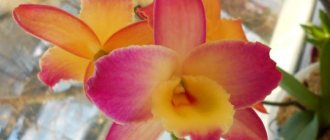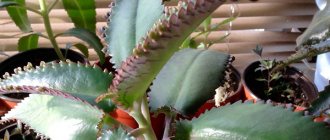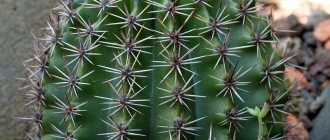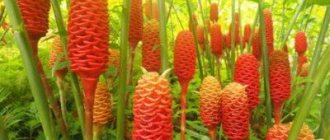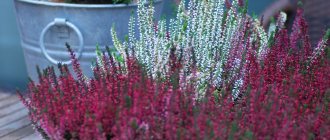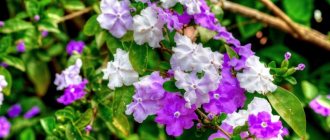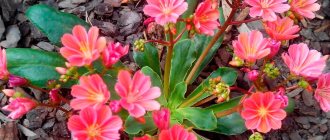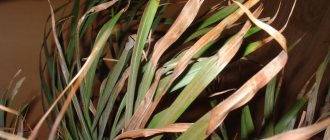Kalanchoe has been known to domestic flower growers for several decades. But until now this plant remains a popular indoor flower, thanks to its simple care, for growing at home. From our article today you will learn about the proper care of Kalanchoe so that it pleases you with its flowering.
Dear readers! For you, we have created communities on social networks in which useful articles and interesting ideas are published several times a day! Subscribe and receive useful content in a convenient format!
Caring for Kalanchoe after purchase
When you bring the purchased flower home, do not place it next to other flowers.
Firstly , the Kalanchoe is replanted. This is done for this reason. The fact is that in flower shops flowers do not grow in normal soil, but in a special nutritious peat-based substrate. That's why the flowers are replanted. So that at home they grow in good soil.
Secondly , the plant needs to get used to a new place and a different microclimate.
Thirdly , the flower may be sick or pests may live on it. Otherwise he will be in quarantine for a couple of weeks. During this time, you will accurately determine whether he is healthy and how he tolerates the conditions of your home.
Description and characteristics of the plant
Kalanchoe is native to the countries of hot Asia, and especially to the island of Madagascar. This explains the plant’s ability to retain moisture and use it very economically. Its peculiarity is its thick stems and fleshy leaves, as if saturated with liquid. A special film covering their glossy surface prevents excessive evaporation in hot weather. This culture belongs to the so-called succulents.
The indoor plant readily blooms with bright inflorescences, mainly in spring and winter. Currently, many hybrids have been developed with a wide variety of colors. The culture is unpretentious, but each variety (and there are more than 200 of them) has its own characteristics of care. You need to get an idea about them before buying a flower.
Growing conditions
Kalanchoe is not one of the picky plants and difficult to care for, but in order for the flowering to be lush and long, and for the succulent to look healthy and strong, it is worth observing certain conditions.
Temperature
Kalanchoe is not too demanding on temperature conditions. 18 - 28 degrees in summer and 15 - 18 degrees in winter will be the optimal home conditions for the flower. At the beginning of winter, it is better to lower the temperature so that the plant gains strength before future flowering. But this is not at all necessary. Just keep in mind that then the flowers will be small and inconspicuous.
IMPORTANT! Do not lower the temperature to 10 - 12 degrees. Kalanchoe can get sick in such cold weather.
Air humidity
Medium humidity is best suited for this flower. Kalanchoe also tolerates short periods of drought and increased humidity well. However, during the hot summer months, you can spray the foliage with a spray bottle. You can’t spray in winter!
Lighting
The flower loves bright sunlight and relatively short daylight hours. But Kalanchoe does not tolerate direct ultraviolet rays very well, so for proper care it should be shaded.
In winter, when the sun is not too aggressive, the Klanhoe pot should be moved to a south window, otherwise you will have to illuminate it with lamps.
In summer, it is better to place the container on the western or eastern side.
Choosing a place to put it
Kalanchoe should be placed on window sills or near windows so that the flower receives the required amount of light.
In the depths of the room, the plant may lose its decorative properties: it will not bloom for long, the buds will become dull, and the color of the foliage will not be as rich.
In summer, a pot of Kalanchoe can be placed outside. A balcony or open veranda is suitable. In this case, fresh air will cool the leaf plates, and the flower will not overheat and suffer from the bright sun.
What does it look like in the interior?
Looks most advantageous in bedrooms and children's rooms. If you have a large house, then the container with the flower can be placed on the porch, veranda or in the living room.
Kalanchoe is not a plant that immediately attracts attention and requires appropriate treatment and care. This flower creates a feeling of comfort and warmth in the room and complements the interior.
At the same time, the plant looks equally good among the cold hi-tech tones and among the soft colors of more traditional bedroom and living room interiors.
How to choose the right one
When purchasing, you should pay attention to what the plant looks like in order to choose a specimen to your liking. By its appearance you can determine whether it is sick, what its flowering pattern is, and whether it is affected by pests. It is recommended to make a purchase at the beginning of winter, when the bush is just entering the flowering phase.
Leaves
The condition of the leaves shows what conditions the plant was in before purchase. You need to choose a flower with dense, fleshy leaves of a uniform dark green color. Damage, spots, inclusions may indicate illness. If the plant is compact and has dense, rich greenery, it means it was grown in ideal conditions. An elongated stem with sparse leaves indicates that the Kalanchoe suffers from a lack of light.
buds
When purchased, the buds must be in the formative stage. Then soon the entire bush will be covered with bright inflorescences. By the color of the buds you can judge what shades the Kalanchoe bush will delight during the flowering period.
Diseases
When purchasing, it is extremely important not to miss the signs of a particular disease. This could be rot, softened areas, stains, or damage.
Pests
Traces of pest activity are usually concentrated on the front and back sides of leaves, stems, in the center of buds or on blooming flowers. Various growths, plaque, and scab-like formations should cause caution.
Care at different times of the year
Depending on the season, some conditions for caring for and growing the plant change slightly.
in spring
Kalanchoe usually ends flowering in spring. This means it’s time to prune: remove old peduncles and leaves, form a crown.
Also, if necessary, the flower is transplanted and propagated in the spring.
In summer
The summer months are the period of plant growth. The flower is gaining strength, so you can include fertilizing in your care.
in autumn
In the second half of autumn, the dormant period begins. The temperature should be reduced to 16 degrees. They also reduce the amount and abundance of watering and stop applying fertilizers.
in winter
With the onset of cold weather and shorter daylight hours, the container with the flower is moved closer to the sun. When flowering begins, Kalanchoe should be well watered and fed to help the flower.
Flowering Kalanchoe at home
It is thanks to Kalanchoe’s ability to bloom not only profusely, but also for a long time that it has become very popular with gardeners. In addition, there are many different varieties that are very different in both the shape and color of the inflorescences.
Flowering of a pet - the joy of the gardener
Time and duration of flowering
Although the plant blooms once a year, this period can last from 3 months or more. For most indoor varieties, flowering time occurs in the winter-spring period, namely from the end of January to the end of March.
With proper care, you can prolong the flowering of Kalanchoe and stimulate re-budding. In this case, the flower will continue to bloom until mid or late summer.
Attention! The main condition for the appearance of inflorescences next year is the creation of conditions for the plant to enter a dormant state.
Does this plant bloom?
Kalanchoe blooms in inflorescences of beautiful small flowers in delicate shades: yellow, red, orange.
Interestingly, the formation of buds in the plant begins when the daylight hours decrease. That is, in the autumn months.
ON A NOTE! This feature is skillfully used by experienced gardeners. While planting the buds, they completely deprive the flower of light for 12 hours: they cover the pot or even hide the Kalanchoe in a closet or pantry. But during the day they make sure that the flower is exposed to the sun’s rays from morning until evening (5 – 6 p.m.).
Kalanchoe blooms in the winter months, but can also bloom for several days in March.
In order for the flowering to be as lush as possible, it is recommended to follow the following care rules:
- Be sure to prune after the Kalanchoe has finished flowering;
- Provide the flower with the required length of daylight;
- Follow the rules for maintaining the plant;
- Be sure to provide a period of rest.
How to make Kalanchoe bloom?
As noted, if you follow the rules of proper care at home, Kalanchoe will delight its owners with its blooming appearance only in the first half of spring. However, in order for the flowering to be abundant and long, it is necessary to perform the following trick: from the end of autumn to the beginning of winter, in the last evening hours you should make sure that the Kalanchoe is in absolute darkness. To do this, you can cover it with a box or place it in a closet. The flower should remain in the dark for 12 to 14 hours a day. The procedure must be repeated for 6 weeks. The described actions contribute to the development of plant buds.
Signs of improper care
- Yellowing of the leaves is caused by improper care or maintenance conditions. Excess or lack of fertilizers, irregular watering, unsuitable soil - all this leads to a change in the color of Kalanchoe leaf blades.
- Stretching and deformation of stems. Kalanchoe grows in one or more tough, erect shoots. If the plant is overly elongated, or its stem bends as it grows, it means the flower does not have enough sunlight.
- Small, inconspicuous flowers, rare inflorescences - all these are signs of the absence of a dormant period. This means that Kalanchoe could not gain strength. When the plant fades, be sure to trim it and move it to a cool place.
- The lower leaves of Kalanchoe may dry out due to a cramped pot. This symptom may also be a consequence of proximity to central heating radiators.
Transfer
This plant tolerates replanting relatively easily, but you should not get carried away with this procedure. Usually a transplant is done when the pot becomes small and when it is saved after overflow, exposure to diseases, pests, etc.
Transfer
The process of replanting Kalanchoe differs little from replanting other indoor flowers.
- First you must choose the appropriate size container. The new pot should be several centimeters larger than the previous one. You should not take a container that is too large, otherwise you may not wait for the buds to appear.
- First, the drainage is laid. Classic material: stones, crushed stone, expanded clay, etc.
- Next, carefully remove the flower from the old container. Inspect the root system for disease and damage.
- Remove diseased and damaged roots. Wash the cut areas with a pink solution of potassium permanganate.
- Plant the flower in a new container and add soil to the desired level. Do not tamp too hard. Lightly press the ground with your palms so that the flower does not fall. It would be enough
- Water with water containing a growth stimulator.
ON A NOTE. It is believed that March is more suitable for transplantation. Flowering usually ends this month, and replanting will not be too stressful for Kalanchoe.
Reasons for lack of flowering
With good care, the plant has beautiful leaves with wavy, pointed or smooth edges and blooms in dense clusters with small flowers. If you buy a Kalanchoe at a flower shop, you usually buy an already flowering specimen and expect the same lush and lush flowering as when you bought it. But after a couple of months, the flowers fall off and dry out, and new buds stop forming, the branches become elongated, and the leaves become smaller. Therefore, any gardener who grows this flower for the first time has a question about why Kalanchoe does not bloom and grows upward.
Problems with flowering occur with many types of flowers, some are difficult to get to bloom at all, especially if suitable conditions are not created for them, they lack nutrients, etc.
There are more than 200 varieties and hybrids of Kalanchoe in the world. Most often in apartments you can find Kalanchoe Blossfeld - a spectacular plant with a lush, bright head of flowers. This species is characterized by long flowering - from February to the end of spring, and at home it can last for a longer period. It is often purchased as a gift: it is no less beautiful than an expensive bouquet, and pleases the eye much longer.
But sooner or later the flowering stops, and no matter what the housewives do, the Blossfeld Kalanchoe does not bloom. What should be done so that the formation of buds continues, the plant is constantly covered with flowers, and the leaves do not become smaller? Without flowers, with deformed small foliage, the elongated bare branches look very unpresentable, there is no decorativeness in them.
There are several reasons why Kalanchoe does not bloom.
- Hybrid. When buying a flower, be sure to check its type. If it's a hybrid, don't expect constant flowering! In America, the plant was nicknamed “disposable” because hybrid varieties have denser inflorescences, topped with large, beautiful flowers and are in greater demand than ordinary ones.
- Incorrect care. Perhaps the wrong conditions were created for keeping this tropical beauty. This may be shade, lack of moisture, too cold a room, or unsuitable soil.
- Overwatering. One of the reasons for stopping growth may be excessive watering, stagnation of water and, as a result, rotting of the roots, the appearance of fungus or gray rot.
- Damage by diseases or pests. Flowers are attacked by powdery mildew, scale insects, aphids, spider mites and many other insects and diseases. They stop the growth and formation of buds, sucking all the juices from the bush.
- Long daylight hours. The tropical resident loves light, but not more than 10 hours. In summer, the pot is removed from the windowsill or the window is darkened in the afternoon, when the peak of the solstice arrives.
- Lack of knowledge about pet care. Every now and then, sellers, trying to sell a flower, assure buyers that the plant is unpretentious and does not require special care, the main thing is to water it on time. But that's not true! Despite the fact that the plant is truly undemanding, it still needs care.
For these and many other reasons, there is no flowering, and the flower grows upward, shedding its leaves, exposing its branches.
Landing
Kalanchoe, like any plant, loves nutritious soil. For planting, you can use a specialized substrate designed for planting succulents.
You definitely need to choose the right pot. It shouldn't be too small or too big.
Plant shoots are planted in the soil when their roots have grown to 1.5 - 2 cm. Please note that young seedlings need to be watered a little more often. A growth stimulator or root formation stimulator can be added to the water. The drug will help the root system develop faster.
Reproduction
Propagation by cuttings
Kalanchoe reproduces well. New plants can be grown from seeds or vegetatively.
The simplest method is propagation by cuttings or leaves. Both parts of the plants take root well.
Kalanchoe can be propagated after flowering and subsequent pruning. Chopped cuttings and leaves are placed in the soil and covered with a jar or plastic bag to create a greenhouse effect. Periodically, the plant is ventilated and sprayed.
You can also place a cutting or leaf in a jar with water and a few drops of a growth stimulator. After a few days, the shoot will take root and then it is transplanted into a pot in a permanent place.
Also, unlike other indoor flowers, Kalanchoe reproduces well by seeds.
Seed material is collected after flowering. The seeds are sown in a fertile mixture at a shallow depth. The container with seeds is covered with a jar or film. Seeds are kept at a temperature of 16 - 20 degrees. They are periodically watered and ventilated.
IMPORTANT! It is better to moisten the soil with a spray bottle. The fact is that with normal watering, the seeds can be washed out of the soil by a stream of water.
After some time, the seeds will germinate. When this happens, the covering material is removed. After 3-4 weeks, picking is carried out. The final transplant to a permanent place is carried out when the plants have formed 4 true leaves.
ON A NOTE. Kalanchoe Degremona easily reproduces by “babies” - small shoots on the leaves. These shoots fall off and take root. Often in one pot with an adult plant you can see a dozen small sprouts that have sprouted from such “babies”.
Leaf of Kalanchoe Degremona
Types of Kalanchoe domestica with photos and names
Kalanchoe Blossfeld
Kalanchoe Blossfeld is considered the most common type of this plant. The plant is approximately 20-30 cm long and feels comfortable in the shade. Many branches extend from the stem, on which grow large green leaves with a red rim. The edge of the leaves is uneven, humpbacked.
The flowering of this species begins in February, the flowers are small in size, arranged in the form of dense inflorescences of a bizarre shape. The duration of this period is 3-4 weeks. The color of the flowers depends on the variety of the species: there are white, orange, yellow, red and pink.
A variety of Kalanchoe Blossfeld is the variety Calandiva. These plants are considered more adapted to life indoors. They are small in size and the flowers are quite large. The Rosalina variety also came from Kalanchoe Blossfeld - this is a low plant with double flowers.
Kalanchoe becharis
The plant is large, tree-like, in nature it can reach a height of 5-6 meters. The stem is dense, thick and long, on it you can see stripes in the form of triangles - the result of falling leaves. The leaves at the bottom of the plant quickly fall off and dry out; they are large in size and can reach a length of up to 20 cm.
The leaves are velvety, uneven, with large teeth. It blooms very beautifully: the flowers are yellow-green, on which you can see purple stripes directed towards the tip of the leaf. The flowers are collected in panicle-shaped inflorescences; their length can reach 35 cm in height.
At home, it is best to leave only young plants on the windowsill, but adult Kalanchoes of this species are suitable for large rooms or greenhouses with sufficient lighting.
Kalanchoe "Tessa"
When flowering, this species has beautiful pink flowers in a fancy bell shape. The flowering time is in the spring, but sometimes it can be in the summer. Ideal for growing at home.
Kalanchoe alochaceae
Kalanchoe alochaceae - the flowers of this species differ from others in their size and shape. They are oblong, hanging, and orange in color.
Kalanchoe Mangina
Kalanchoe Mangina - appearance is characterized by small leaves, oblong in shape with a sharp edge, the length of the leaf is about 2 cm in length. The bell-shaped flowers are orange-red, but breeders have developed varieties of other colors. The inflorescences of the plant consist of 2-15 small flowers that hang on long stems. A plant of this type needs to be sprayed more often than others, since the duration of the flowering period depends on this.
Trimming
After flowering, Kalanchoe is pruned. Old peduncles must be removed. They are no longer needed and only waste the plant's energy and nutrients. Also, after flowering, you can cut cuttings and root them. You will get both propagation and pruning at the same time.
Experienced flower growers also advise pinching the top of Kalanchoe. This is done in order to limit the upward growth of shoots and stimulate the growth of lateral stems. This will make the plant look more lush and beautiful.
How to form a crown
Small specimens of Kalanchoe in the form of dense bushes are most valued. To do this, carry out formative pruning.
What does it mean? Firstly , Kalanchoe will have to be trimmed literally a few months after purchase. Secondly , be sure to pinch the top. Thirdly , you need to constantly remove old flower stalks and leaves. Fourthly , pruning should be regular. Don't let the plant grow.
IMPORTANT! Use a sharp blade for trimming. You can disinfect a regular stationery knife.
At the same time, you shouldn’t get carried away. Just decide how you see the flower, and then strive to bring this image to life by removing excess shoots.
Trimming and shaping
All Kalanchoes tend to stretch and grow over time. Of course, for some time after purchase, Kalanchoe looks like a miniature, squat bush (and only if it is properly cared for), but gradually, at home, the decorativeness of the plant decreases. The stems are stretched, the leaves become smaller.
To prevent this from happening, Kalanchoe must be shaped by pruning and pinching.
Kalanchoe is pruned immediately after it has finished flowering. Cut off faded flower stalks and shorten the stems. New shoots will appear at the site of the cuts, which can also be pinched for further branching.
Typically, pruning and shaping of Kalanchoe is carried out in spring/summer. Then, by autumn, many young shoots grow on the plant, ready to produce flower stalks. If you plan to stimulate the plant to flower at another time (this is possible by artificially reducing daylight hours, this is written below - scroll down the page), then pruning should be stopped a couple of months before the start of stimulation.
Kalanchoe pruning technology
Watering and other water procedures
Watering is the most important part of plant care. Kalanchoe loves abundant watering, but does not tolerate stagnation of water in the soil. The soil must dry out well. To prevent water from remaining in the pot and rotting processes occurring, all excess water from the pan must be drained.
The watering regime in winter and summer differs. During the cold season, watering is rarely necessary. About twice a month. In summer, watering can be more frequent.
NOTE! Overfilling is fraught with the appearance of mold and the development of fungal diseases.
In general, Kalanchoe does not like high humidity and feels better in temperate climates. But in the summer, on especially hot days, the flower can be sprayed with a spray bottle. This should be done carefully. In winter, spraying is strictly prohibited.
Also in the summer, the leaf plates are wiped with a soft, slightly moistened cloth. The fact is that the layer of dust slows down the process of photosynthesis and the leaves lose their decorative effect.
Top dressing
Kalanchoe is a hardy plant and, unlike other indoor flowers, does not require regular feeding.
Fertilizers are applied in summer and autumn. Feeding in the summer months is needed so that the plant regains its strength after flowering and gains green mass. In autumn, fertilizers are applied, as this is the time when buds are formed.
Fertilizers for cacti are suitable for feeding Kalanchoe. Feeding schedule: once every 2 weeks when applying organic fertilizers, once every 7 days when applying mineral fertilizers.
Diseases and pests
Kalanchoe is a plant resistant to diseases and pests. Basically, all diseases are the result of improper care.
One of the most common diseases is rot, which occurs when the plant is overwatered and kept at high humidity.
Powdery mildew may also occur. This disease also occurs due to overwatering and keeping the flower in too hot a place.
Among other diseases, it is worth noting the ring spice virus and the virus that gives abnormal growth. These diseases are quite rare, but are incurable. They manifest themselves as lightening and the appearance of light spots on the leaves. The leaf blades become rough to the touch and ugly. A sick plant cannot be saved, and it is destroyed.
Of the insect pests, Kalanchoe is most often attacked by mites, aphids and scale insects. The mites leave yellow droplets on the leaf blades, and then the leaves die. The presence of aphids can be determined by curled leaf blades. The scale insect reveals itself by the appearance of white discharge.
Diseases and pests must be controlled with insecticides and fungicides. The most effective drugs are Fitoverm, Aktara, Iskra, Vertimek. Folk remedies can also be used, but remember that they do not guarantee 100% results.
IMPORTANT! If signs of disease are detected, be sure to quarantine the plants.
Care
Location and lighting
Loves bright rooms with diffused light. In the summer, it should be placed on windows located towards the west and east. Direct sunlight should be avoided to avoid leaf burns. Loves fresh air, but drafts should be avoided. In winter and during the flowering period, you can use phytolamps if daylight is not enough (the plant begins to stretch and the inflorescences become smaller). The complete absence of light also negatively affects indoor plants.
If a gardener wants the Kalanchoe to bloom, it is necessary to provide it with full lighting for ten hours, i.e. make daylight hours shorter.
Temperature
The Kalanchoe flower can easily withstand high temperatures in summer, up to thirty degrees or more. In winter, you need to maintain a cool temperature of +16-18 degrees (not lower than +10), this helps the rapid formation of flower buds. When it is cool, the flower becomes comfortable to bloom. If the room is too hot, this process is suspended.
Air humidity
Air humidity does not play a key role in the life of a plant. Kalanchoe thrives in both dry air and high humidity. There is no need to spray the plant, but sometimes you can wipe the leaves with a damp cloth or sponge to remove dust. After this procedure, it is necessary to repeat wiping with a dry cloth.
Watering
Moderate, with drying out of the top layer of soil. In summer - about 1-2 times a week (but do not forget to check the soil). In winter, watering should be done a minimum number of times. Kalanchoe can tolerate an insufficient amount of water, but an excess will destroy it, because... may lead to root rot. If the soil dries out greatly, the plant may shed its leaves.
The soil
For such an unpretentious plant as Kalanchoe, you can choose any soil for succulents. It can usually be found in many flower shops. A skilled gardener can create such soil himself. To do this, you need to mix peat, turf and leaf soil in equal quantities. You can add charcoal. It is necessary to put drainage at the bottom of the flower pot. (Read more about how to prepare the soil in this article).
Fertilizer
It is enough to fertilize non-flowering species once a month during the growth period (spring-summer). They bloom once every three weeks in spring and summer, and also in autumn (for the formation of flower buds). In cold weather, you should absolutely not fertilize the plant. Even if it withers, you cannot . It is recommended to use store-bought fertilizers for succulents or complex fertilizers (mineral and organic) with a low nitrogen content.
Do not forget about this important factor in feeding the plant: the fertilizer must be diluted in warm water. Then you need to wait a while for it to cool down and then you can fertilize the flower.
Transfer
It is necessary to replant a houseplant if the flower pot in which the Kalanchoe is currently located becomes too small for it. Replanting may also be required when the plant’s soil begins to rot after prolonged watering.
Young Kalanchoe requires annual replanting due to the rapid growth of roots. It is recommended to do this when the spring period ends. To replant, you need to take the plant out of the flower pot along with a small amount of soil, place it in another and water it.
Then the plant begins to slowly adapt to its new “place of residence.” In the new pot, it is necessary to maintain equal proportions of new soil and existing soil. Most often, Kalanchoe goes through an adaptation period of seven days. After which you can feed the flower. When choosing a new flower pot, you should choose wide and deep shapes. (For more information on how to replant a succulent, read this article).
How to resuscitate?
The advantage of Kalanchoe is that it can be saved relatively easily. If you overwater a flower and it begins to rot, or, conversely, the plant dries out, simply cut off the top (or several shoots) and root it. Quite quickly the shoot will take root and take root. Then you will transplant it into a new pot.
ON A NOTE. In fact, Kalanchoe cannot be saved only if the flower is infected with a virus or fungus. In this case, it is better to destroy the plant so that the disease does not spread to your other pets.
Benefits and harms for humans
In addition to its decorative value, Kalanchoe also has medicinal properties.
For example, an infusion of finely chopped leaves of the plant is used to treat runny nose and colds.
The juice is used to treat ulcers from burns, stomatitis and frostbite.
Kalanchoe also purifies indoor air.
INTERESTING. Thanks to its healing properties, Kalanchoe received the nickname “Indoor Ginseng”.
Such different Kalanchoe...
But Kalanchoe can look different, because this genus includes as many as 200 species! Some of them are particularly decorative and have bright colors, while others have medicinal properties.
Most often grown at home:
- Kalanchoe Blossfeld - distinguished by decorativeness. Forms a compact bush, blooms with elegant umbrella inflorescences. The well-known variety series - Kalanchoe Kalandiva is characterized by double flowers.
- Kalanchoe Degremona is medicinal; the juice from its fleshy leaves is used to heal wounds, get rid of runny nose, etc. Belongs to bryophyllum (viviparous Kalanchoe, reproducing by “babies”).
- Kalanchoe pinnate is also a medicinal bryophyllum. Its oval leaves with vein patterns resemble feathers, which is how the species earned its name.
- Kalanchoe Mangina (Mangini) is a decorative bryophyllum with long shoots that form an ampelous bush. Blooms with bright red bell flowers.
- Kalanchoe tubiflora (tubiflora) is an interesting bryophyllum with narrow leaves tucked inward and with many “babies” along their edges.
- Kalanchoe dissected - the so-called “deer horns”. Produces long shoots with dissected narrow leaves, shaped like deer antlers.
There are many other species, for example, Kalanchoe tomentosa, Kalanchoe paniculata, etc., but they are grown much less frequently.
Types of Kalanchoe
However, you can grow any Kalanchoe at home, following certain care rules. They are almost the same for both flowering and deciduous species of this wonderful plant.
Common mistakes
- Too much watering and high air humidity. Due to excess moisture, some parts of the plant begin to rot.
- Lack of light. Kalanchoe loses its attractiveness, stretches out and becomes ugly.
- Lack of fertilizing. The flower becomes inconspicuous and often gets sick.
- No rest period. Inconspicuous and weak flowering in the new season.
- Temperature too low. At temperatures below 10 degrees, Kalanchoe dies.
At what temperature should Kalanchoe grow?
Another important condition for caring for Kalanchoe at home is the ideal ambient temperature for it. The flower does not tolerate low temperatures well and may even die, which means that in the winter season it is necessary to ensure that cold air currents do not affect the plant.
Recommended temperatures for normal growth of Kalanchoe in winter should be between 15-18 ºC. Under no circumstances should the air temperature drop below 10 ºC, otherwise the death of the flower will be inevitable.
In the summer, it is also recommended to monitor the thermometer readings in the places where the plant pot is located, since high temperatures are also harmful to it. It is recommended that in summer the air temperature should be within 21 ºC.
Answers to popular questions
Why do the leaves of the flower turn red?
If the leaves have acquired a reddish tint, then there is nothing to worry about. This happens when the bryophyllum stands in a well-lit place.
But, if the redness is too strong, then it is very likely that the leaf blades are overheating. Shade the flower.
Why did the leaves of the flower turn yellow?
Yellowing of the leaf blades indicates improper care. Normalize the watering and fertilizing regime, make sure that the plant has enough sunlight.
The flower grows crookedly and looks ugly, what should I do?
Most likely there is not enough sun. The second possible reason is that the pot is too small. After flowering, prune or replant.
How to propagate Kalanchoe?
When the plant has finished flowering, cut off a few shoots and place them in a jar of water. After some time, roots will appear. Replant the Kalanchoe into a pot.
Is it possible to be treated with an infusion (decoction) of Kalanchoe?
Traditional medicine knows many recipes with this healing plant. But we advise you not to self-medicate, but to seek medical help from a doctor.
Origin of Kalanchoe
The described inhabitant of the windowsill is considered a medicinal representative of the flora, often used for nasal congestion and other inflammatory processes. The question of whether flowering Kalanchoe can be used for medicinal purposes is still controversial. But even if it is impossible to get rid of a runny nose with the help of such a plant, it will delight its owners with its flowers.
This type of indoor decoration belongs to the Crassulaceae family, and translated means “plant with thick skin.”
The island of Madagascar is considered the birthplace of the green creature, but its growth can be found almost throughout Asia. The flowering beauty is grown both in greenhouses and in the room. This type of indoor decoration belongs to the Crassulaceae family, and translated means “thick-skinned plant.” Thanks to its thick stems and leaves, it accumulates moisture and goes without watering for a long time. Evaporation is prevented by a thin film covering the leaves and stems. All these features must be taken into account in order to care for a blooming creature.
Let's highlight the basic principles of care:
- Watering mode.
- Requirements for illumination and temperature.
- Transfer.
- Reproduction methods.
- Feeding, pruning.
- Protection from diseases.
Now let’s try to consider each of the mentioned principles in detail.
Video clip on how to grow Kalanchoe at home
Conclusion
Kalanchoe is a simple and easy-to-care flower. In skillful hands and with proper care, it can become a real decoration. Even any gardener can cope with the flower, and the fact that the plant reproduces easily and is not afraid of pruning and replanting will help a novice florist not be afraid to make a mistake.
Kalanchoe fits into any interior and looks beautiful almost anywhere in the house or apartment.
